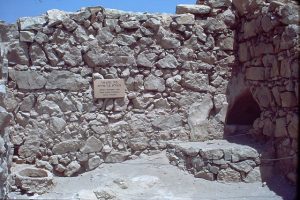Hellenistic Trends in Palestinian Judaism, Lawrence H. Schiffman, Reclaiming the Dead Sea Scrolls, Jewish Publication Society, Philadelphia, 1994.

Masada casemate room, site of the discovery of the Ben Sira scroll. By Wctrenchard – Own work, CC BY-SA 4.0, https://commons.wikimedia.org/w/index.php?curid=121760693
The Jewish group least affected by the process of Hellenization was the peasantry, who visited the cities mainly to sell their produce or to make religious pilgrimages to Jerusalem. In the cities they certainly came into contact with more Hellenized Jews and with non-Jews. Yet their language and culture remained Hebraic, and Hellenism’s influence on them was restricted largely to the use of Greek words for the various new items they encountered. On the whole, these common people had no intention of abandoning their ancestral way of life for the new cultural symbiosis.
The situation of the urban masses was very different. Although artisans and traders lived in predominantly Jewish cities, the extent of their contact with the Greek world was much greater than that of residents in rural areas. Literature such as the Book of Ben Sira (Ecclesiasticus), parts of which were found at Qumran and Masada, testifies to the moderate influence of Hellenistic culture on traditional and pious Jews in the early second century B.C.E.
The urban population found itself forced to use the Greek language simply to be understood. Increasingly, throughout the third and second centuries B.C.E., Hellenism exercised a greater and greater influence on architecture and cultural life even among traditionally pious Jews. Certain aristocratic families connected closely with the priesthood were more Hellenized than most other Jews in these cities, perhaps as a result of their greater contact with the wider Hellenistic world or for political and economic reasons.
Those Jews who were interested in an even greater form of Hellenization gravitated to the Greek cities, mostly on the seacoast and in the area later known in Roman times as the Decapolis, located in the northern Jordan valley and Transjordan. In these regions, Greek was the everyday language, and the dominant culture was Hellenistic. Such Jews compromised with the pagan cults primarily by interpreting the city liturgies as extensions of their monotheistic Judaism. Indeed, they radically reinterpreted the Jewish Scriptures to be consistent with these pagan cults. In order to ease the transition from the ancient Near Eastern life of the Palestinian Jew to the new, cosmopolitan life of the Hellenistic Jew, this Jewish group tried to remake Judaism into a subculture of the Greek cosmos.
These trends coexisted for a time within Judaean society until they came into open confrontation. Beginning in the late second century B.C.E., extreme Hellenizers of the type previously known only in the Greek cities took control of the Jerusalem priesthood and attempted to transform Jerusalem into another Hellenistic polis. This event set the stage for the Maccabean Revolt.
Pages 68-69
What do you want to know?
Ask our AI widget and get answers from this website